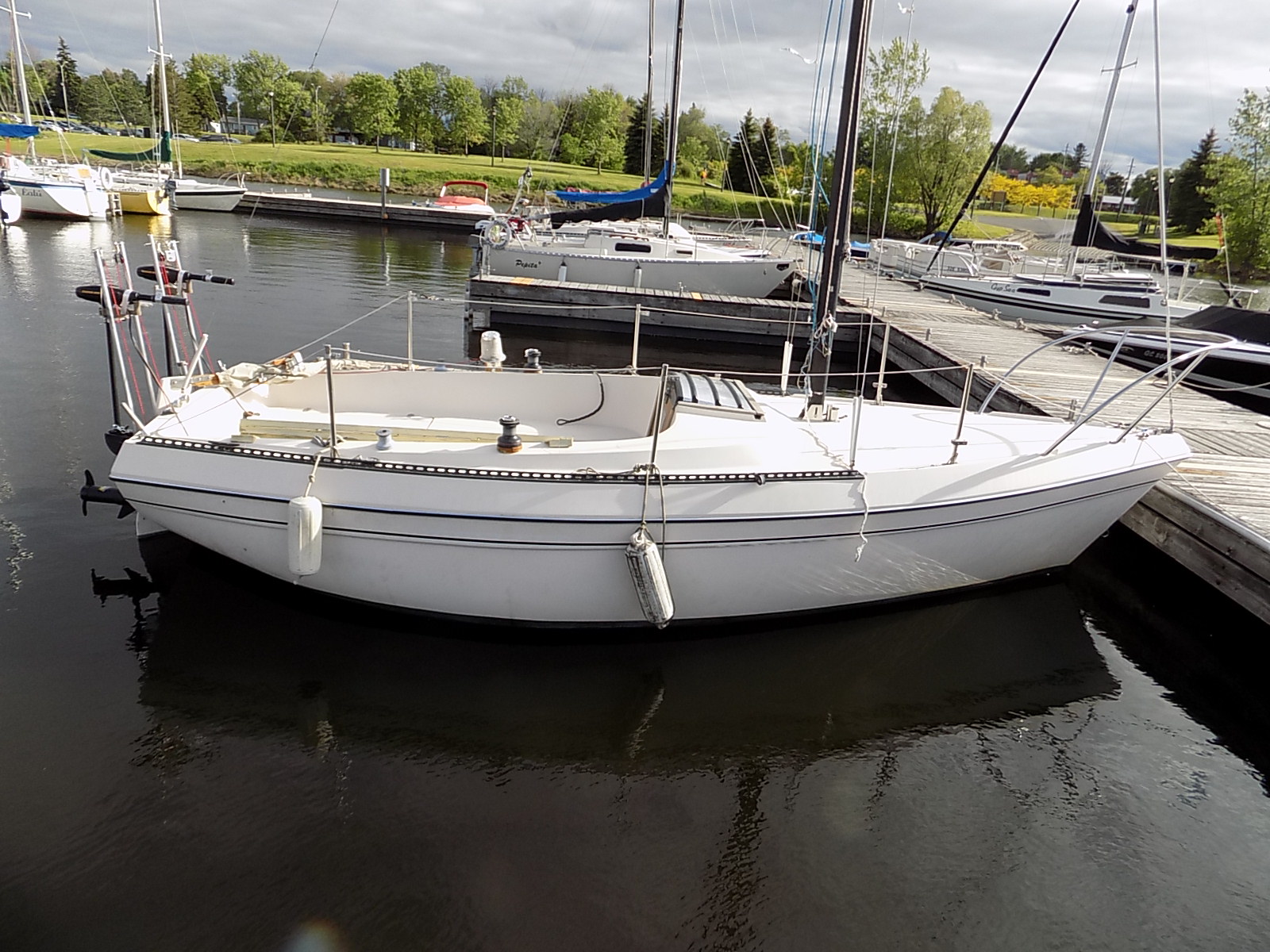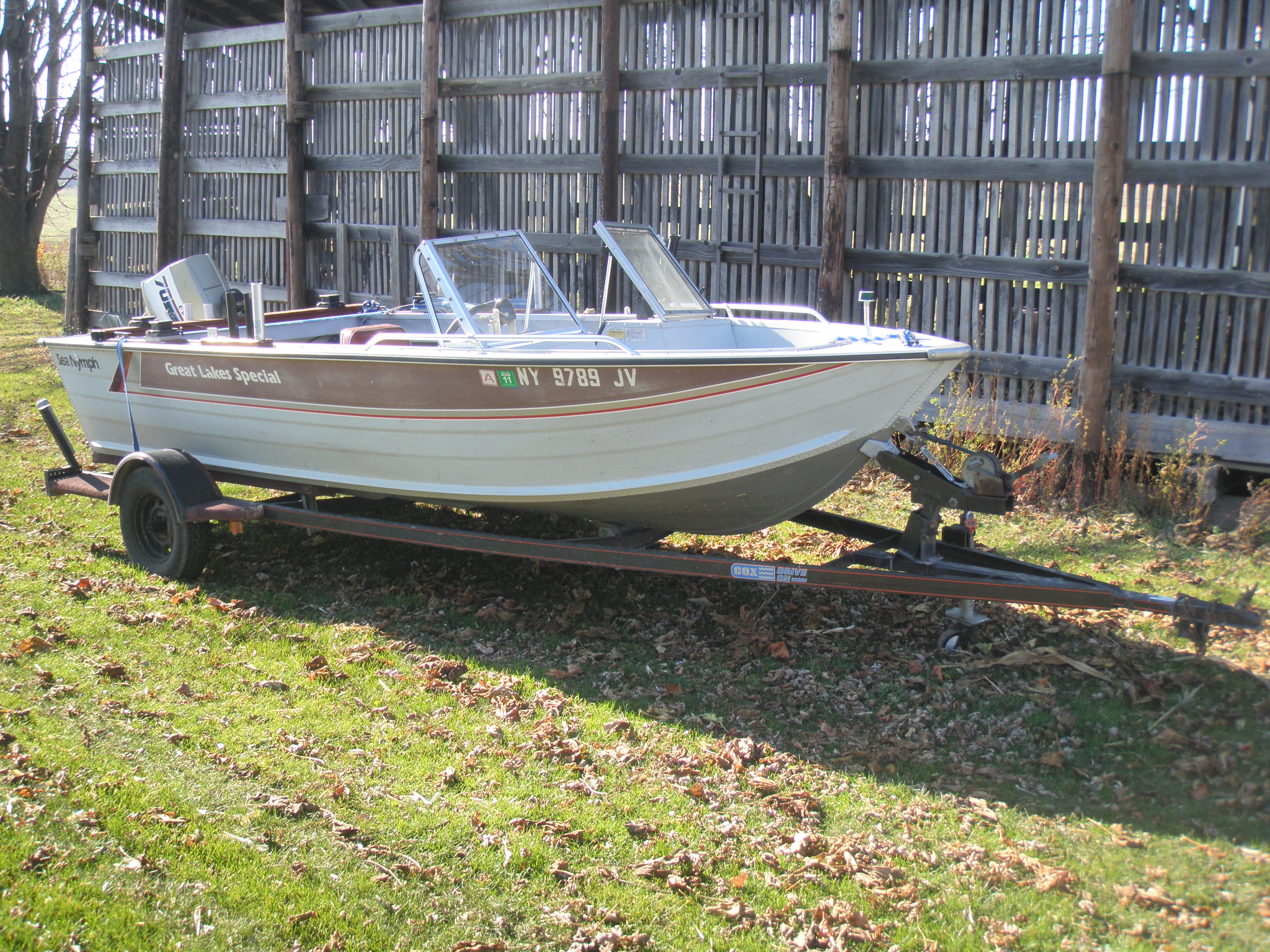|
Jeanneau Arcachonnais
The Jeanneau Arcachonnais is a French Trailer sailer, trailerable sailboat that was designed as a day sailer and pocket cruiser, first built in 1969. Production The design was built by Jeanneau in France, starting in 1969, but it is now out of production. Design The Arcachonnais is a recreational keelboat, built predominantly of fiberglass. It has a Fractional rig, fractional sloop rig, with a deck-stepped mast and aluminum spars. The hull has a raked stem, an angled Transom (nautical), transom, a transom-hung rudder controlled by a tiller and a fixed stub keel with a retractable centerboard. It displaces and carries of ballast. The boat has a draft of with the centerboard extended and with it retracted, allowing operation in shallow water or ground transportation on a boat trailer. The boat is normally fitted with a small outboard motor for docking and maneuvering. The design has sleeping accommodation for two people, with a double "V"-berth in the bow cabin. The desi ... [...More Info...] [...Related Items...] OR: [Wikipedia] [Google] [Baidu] |
Jeanneau
Jeanneau is a French boatyard in Les Herbiers, in the Vendée département, which has produced yachts since 1957. It was founded by Henri Jeanneau, a hardware store owner, who began by producing power boats. Jeanneau specializes in monohulls, but it created a specialist multihull line, Lagoon catamarans. Jeanneau (and Lagoon) became part of Groupe Beneteau in 1995. History Henri Jeanneau's first boats in 1957 were wooden outboard motor-powered dinghy designs. He quickly moved to producing boats from fiberglass and by 1960 his motorboats, including the Jeanneau Sea-bird, were made from this new material, followed by the first sailboats in 1964. In 1970 the company was purchased by the American conglomerate, Bangor Punta. By mid-1980 the company was sold again and became part of Chatellier SA. In 1990 there was a joint venture with Italian Ferretti Craft to build a series of yachts, but the project did not last long. In 1995 the company was bought out by Groupe Beneteau an ... [...More Info...] [...Related Items...] OR: [Wikipedia] [Google] [Baidu] |
Fractional Rig
A fractional rig on a sailing vessel consists of a foresail, such as a jib or genoa sail, that does not reach all the way to the top of the mast. The forestay is a wire that secures the mast to the front of the boat. With a fractional rig, the forestay is attached between about 1/8 and 1/4 of the length of the mast lower down, rather than being attached to the top of the mast as in a masthead rig. The foresail (jib or genoa) is then rigged to this stay. The mast is farther forward on the boat than on a masthead rig and so it has a larger mainsail. Masthead rigs are most common on larger keelboats or cruisers. A fractional rig is typically used on sailing dinghies and racing oriented keelboats, such as the J/24. Fractional rigs were introduced on race boats in order to allow more controllability of the surface of the mainsail and also less drag when sailing upwind. According to one manufacturer, "a key to making fast boats easier to sail than slow boats is the 'fractio ... [...More Info...] [...Related Items...] OR: [Wikipedia] [Google] [Baidu] |
Buzzards Bay 14
The Buzzards Bay 14 is an American sailboat that was designed by L. Francis Herreshoff and first built in 1940.Sherwood, Richard M.: ''A Field Guide to Sailboats of North America, Second Edition'', pages 88-89. Houghton Mifflin Company, 1994. The Buzzards Bay 14 is a scaled-up development of the Herreshoff 12½, which was designed by L. Francis Herreshoff's father, Nathanael Greene Herreshoff. Production The design was commissioned by Llewllyn Howland and was intended to be built by the Concordia Company in the United States out of wood, but few were completed as the company concentrated on the Beetle Cat instead. In the mid-1980s production was commenced in fiberglass, with 17 boats completed by 1994. Today the design is built in fiberglass by the Buzzards Bay Boat Shop of North Falmouth, Massachusetts and from wood by Artisan Boatworks in Rockport, Maine. Design The Buzzards Bay 14 is an open recreational keelboat with a foredeck. It has been built of wood or, more recen ... [...More Info...] [...Related Items...] OR: [Wikipedia] [Google] [Baidu] |
Buccaneer 200
The Buccaneer 200 is an American trailerable sailboat, that was designed by Alan Payne and first built in 1974. The Buccaneer 200 is a development of the Columbia T-23 design, using the same tooling to build the hull. Production The boat was built by Bayliner Marine Corporation in the United States starting in 1974, but it is now out of production. Design The Buccaneer 200 is a small recreational keelboat, built predominantly of fiberglass, with wood trim. It has a masthead sloop rig, a transom-hung rudder and a fixed long shoal-draft keel. It displaces and carries of ballast.Henkel, Steve: ''The Sailor's Book of Small Cruising Sailboats'', page 87. International Marine/McGraw-Hill, 2010. The boat has a draft of with the standard keel, allowing beaching or ground transportation on a trailer. It is normally fitted with a small outboard motor for docking and maneuvering. The cabin is small but includes a double berth, a quarter berth, galley with a sink and a fold dow ... [...More Info...] [...Related Items...] OR: [Wikipedia] [Google] [Baidu] |
List Of Sailing Boat Types
The following is a partial list of sailboat types and sailing classes, including keelboats, dinghies and multihull ( catamarans and trimarans). Olympic classes World Sailing Classes Historically known as the IYRU (International Yacht Racing Union), the organization evolved into the ISAF (International Sailing Federation) in 1996, and as of December 2015 is now World Sailing. Dinghies Keelboats & yachts Multihulls Boards Radio-controlled Former World Sailing-classes Dinghies Keelboats & yachts Multihulls Boards Other classes and sailboat types Dinghies Keelboats & yachts Multihulls See also * Classic dinghy classes * List of boat types * List of historical ship types * List of keelboat classes designed before 1970 * Olympic sailing classes * Small-craft sailing * Clansman 30 Notes References {{DEFAULTSORT:Sailing boat types Types * Boat types A boat is a watercraft of a large range of types and sizes, but ge ... [...More Info...] [...Related Items...] OR: [Wikipedia] [Google] [Baidu] |
Hull Speed
Hull speed or displacement speed is the speed at which the wavelength of a vessel's bow wave is equal to the waterline length of the vessel. As boat speed increases from rest, the wavelength of the bow wave increases, and usually its crest-to-trough dimension (height) increases as well. When hull speed is exceeded, a vessel in displacement mode will appear to be climbing up the back of its bow wave. From a technical perspective, at hull speed the bow and stern waves interfere constructively, creating relatively large waves, and thus a relatively large value of wave drag. Ship drag for a displacement hull increases smoothly with speed as hull speed is approached and exceeded, often with no noticeable inflection at hull speed. The concept of hull speed is not used in modern naval architecture, where considerations of speed/length ratio or Froude number are considered more helpful. Background As a ship moves in the water, it creates standing waves that oppose its movement. T ... [...More Info...] [...Related Items...] OR: [Wikipedia] [Google] [Baidu] |
"V"-berth
A berth is a bed or sleeping accommodation on vehicles. Space accommodations have contributed to certain common design elements of berths. Beds in boats or ships While beds on large ships are little different from those on shore, the lack of space on smaller yachts means that bunks must be fit in wherever possible. Some of these berths have specific names: ;V-berth: Frequently yachts have a bed in the extreme forward end of the hull (usually in a separate cabin called the forepeak). Because of the shape of the hull this bed is basically triangular, though most also have a triangular notch cut out of the middle of the aft end, splitting it partially into two separate beds and making it more of a V shape, hence the name. This notch can usually be filled in with a detachable board and cushion, creating something more like a double bed (though with drastically reduced space for the feet; 12" wide is typical). The term "V-berth" is not widely used in the UK, instead the cabin a ... [...More Info...] [...Related Items...] OR: [Wikipedia] [Google] [Baidu] |
Boat Trailer
A boat trailer is designed to launch, retrieve, carry and sometimes store boats. Commercial boat trailers Commercial hydraulic boat trailers are used by marinas, boat yards, boat haulers, boat dealers and boat builders. Generally this type of trailer is not used for storage of the boat. Self-propelled Self-propelled boat movers are not strictly trailers, but hydraulically operated boat movers, with their own tractor unit. They share all of the features of hydraulic boat trailers. Non-commercial boat trailers This type of trailer is usually used by the boat owner/operator. The trailer is also used for storage. * Roll-on, also known as a "Roller style trailer", uses rubber and/or polyurethane rollers for ease of launching and loading a boat. * Glide-path, also known as a "Float-on style trailer", allows the boat to float onto the trailer; after the trailer has been partially submerged (usually of the trailer). Since its inception, it has become quite popular compared to the ... [...More Info...] [...Related Items...] OR: [Wikipedia] [Google] [Baidu] |
Keel
The keel is the bottom-most longitudinal structural element on a vessel. On some sailboats, it may have a hydrodynamic and counterbalancing purpose, as well. As the laying down of the keel is the initial step in the construction of a ship, in British and American shipbuilding traditions the construction is dated from this event. Etymology The word "keel" comes from Old English , Old Norse , = "ship" or "keel". It has the distinction of being regarded by some scholars as the first word in the English language recorded in writing, having been recorded by Gildas in his 6th century Latin work '' De Excidio et Conquestu Britanniae'', under the spelling ''cyulae'' (he was referring to the three ships that the Saxons first arrived in). is the Latin word for "keel" and is the origin of the term careen (to clean a keel and the hull in general, often by rolling the ship on its side). An example of this use is Careening Cove, a suburb of Sydney, Australia, where careening was carried ... [...More Info...] [...Related Items...] OR: [Wikipedia] [Google] [Baidu] |
Tiller
A tiller or till is a lever used to steer a vehicle. The mechanism is primarily used in watercraft, where it is attached to an outboard motor, rudder post or stock to provide leverage in the form of torque for the helmsman to turn the rudder. A tiller may also be used in vehicles outside of water, and was seen in early automobiles. On vessels, a tiller can be used by the helmsman directly pulling or pushing it, but it may also be moved remotely using tiller lines or a ship's wheel. Rapid or excessive movement of the tiller results in an increase in drag and will result in braking or slowing the boat. Description A tiller is a lever used to steer a vehicle. It provides leverage in the form of torque to turn the device that changes the direction of the vehicle, such as a rudder on a watercraft or the surface wheels on a wheeled vehicle. A tiller can be used by directly pulling or pushing it, but it may also be moved remotely using tiller lines or a ship's wheel; some kay ... [...More Info...] [...Related Items...] OR: [Wikipedia] [Google] [Baidu] |




